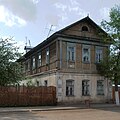Borovsk
Эта страница на русском: Боровск
| Object location | | View all coordinates using: OpenStreetMap |
|---|
Borovsk, a town established in 1358, stands between Moscow and Kaluga. Current population is estimated at around 12 thousand.
Symbols
[edit]-
Coat of arms
-
Flag
Geography
[edit]Borovsk was founded on the steep right bank of the Protva River. The town developed primarily to the south of the old citadel. Isolated suburbs (slobodas) developed to the west (across the Tekizha Creek Ravine) and to the north and east, across the Protva.
-
The Protva near old citadel
-
The Protva near old citadel
-
One of many green islands on the Protva
-
The Protva in Borovsk
-
The Protva in Borovsk
-
Fish in the Protva
The small Tekizhe Creek flows into the Protva east of the old town, in a grand natural ravine. It forms the natural border of the city core, separating it from the eastern suburb.
-
Tekizhe Creek
-
View east across the ravine
-
View north along the ravine
-
View west across the ravine
-
Hills east of Borovsk
-
Fields west of Borovsk
-
Fields east of Borovsk
-
Woodland north of Borovsk
-
Valley of the Protva west of Borovsk
-
Valley of the Protva west of Borovsk
No traces of ancient fortresses survived to date. The old Kremlin Hill is scarcely built out, and most of these small buildings are occupied by the town hall and district court.
-
The top of the hill
-
City Hall
-
The (alleged) grave of Fedosiya Morozova
-
Painters on the crest of the hill
-
View west from the hill
-
View north-east from the hill
Lenin Square, the former Market Square, stands immediately south-west of Kremlin Hill. To date, the square remains the shopping center of the town - there are no modern "shopping plazas" or big label supermarkets. The Square is also home to local museum and library. There are monuments to Lenin, philosopher Nikolay Fyodorov and a small World War Two memorial cemetery.
-
Old market, view from west
-
South-east corner
-
North-west corner
-
North-west corner
-
Old shop buildings
-
North side
Streets of the core town (west to east)
[edit]Western suburb
[edit]-
Bernikova Street
-
Bernikova Street
-
Bernikova Street
Southern suburb
[edit]-
Rabochaya Street
-
Rabochaya Street
-
Kalinina Street
Eastern suburb
[edit]-
The church and the gardens
-
Kommunisticheskaya Street
Northern suburb
[edit]-
Engelsa Street
-
Engelsa Street
-
Engelsa Street
-
Municipal beach and footbridge to the Citadel
-
Municipal beach
Architecture
[edit]Historically, Borovsk was a town of die-hard Old Believers.
-
Cathedral of the Annunciation (Moscow Patriarchy)
-
Church of St. Boris and Gleb (Moscow Patriarchy)
-
Church of the Entry (former Old Believers, now Moscow Patriarchy)
-
Church of the Exaltation of the Cross (Moscow Patriarchy)
-
Church of the Intercession (Moscow Patriarchy)
-
Church of the Transfiguration (Moscow Patriarchy)
-
Cathedral of All Saints (former Old Believers, now secularized)
-
Cathedral of the Intercession (Old Believers)
-
Church of the Intercession (former Edinoverie, now secularized)
-
Setting
-
Entrance
-
Cathedral
-
Belltower
-
Fortifications
Museums
[edit]-
Local library and history museum
-
The Center of Arts in the former Cathedral of All Saints
-
Folk art commune in the former Shokin House
Typical small single-family homes
[edit]Larger wooden houses on brick basements
[edit]Murals
[edit]Borovsk has more murals than Belfast. Almost all of these murals were created in the 2000s by local artist Vladimir Ovchinnikov (http://vladiov.narod.ru/), mostly in grisaille. Freedom of panorama prohibits hosting of his artwork per se, but hopefully these examples pass de minimis exemption:
-
The Globe of Borovsk
-
The Polezhaev family
-
The Cathedral
-
Old photographs
-
Old photographs
-
Tsiolkovsky and Cucumber
Nearby villages
[edit]-
View from across the Protva
-
Another view from afar
-
Church of Archangel Michael
-
Church of Archangel Michael
-
Footbridge
-
Nearby fields
-
Riverside houses
-
Bridge and the church of St. Barbara
-
Church of St. Barbara
-
Church of St. Barbara
-
Nearby fields
-
Fields slated for development
-
View from Borovsk
-
Church of the Nativity of Theotokos
-
Quiet alley
-
Abandoned house
-
Dacha township
-
Nearby forest
-
Landscape
-
Church of St. Demetrios
-
Wooden houses
-
Run-down house
-
Main Street
-
Main Street
-
View from Ryabushki
-
The hills
-
Church of St. Nicholas
-
Main Street
-
Main Street
-
Main Street




















































































































































